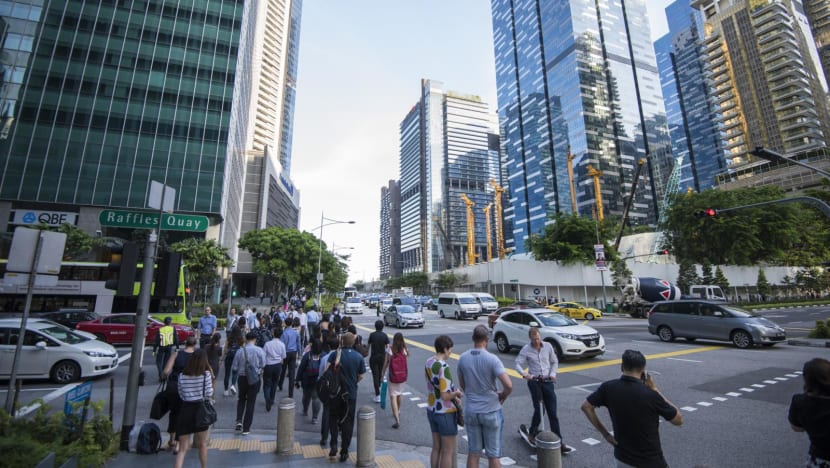Singapore downgrades 2025 GDP growth forecast to 0 to 2%, citing impact of Trump tariffs on global trade
The tariffs imposed by Trump and the ongoing trade war between the US and China are expected to "weigh significantly on global trade and global economic growth", says the Ministry of Trade and Industry.

Office workers in the central business district of Singapore. (File photo: iStock)

This audio is generated by an AI tool.
SINGAPORE: Singapore has downgraded its gross domestic product (GDP) growth forecast for 2025 to 0 per cent to 2 per cent, the Ministry of Trade and Industry (MTI) said on Monday (Apr 14), citing the impact of US President Donald Trump's tariffs on global trade.
The Monetary Authority of Singapore (MAS) also loosened monetary policy for the second time in a row as economic fears rise due to the trade war brewing between the US and China and lowered core inflation expectations for the year.
Economists polled by Reuters had expected annual growth of 4.3 per cent in the January to March period.
MTI noted that in February, Singapore’s GDP growth forecast for the year remained at 1 per cent to 3 per cent. This took into account an expected easing in the overall growth of Singapore’s key trading partners, including the US and China.
"Since then, the US has imposed a baseline tariff of 10 per cent on all countries and higher reciprocal tariffs targeted at countries that run large trade surpluses with the US," said the ministry.
It added that the tariffs imposed by Trump and the ongoing trade war between the US and China are expected to "weigh significantly on global trade and global economic growth".
The growth outlook of economies in the region will be "negatively affected" by a fall in external demand partly due to the tariffs’ wider impact on global trade and growth.
"Business and consumer sentiments will also be dampened, thereby crimping domestic consumption and investments in many economies," said MTI.
Singapore's economy grew 3.8 per cent in the first quarter of 2025, slower than the 5 per cent growth in the previous quarter, according to advance estimates from the ministry. On a quarter-on-quarter seasonally adjusted basis, the economy contracted by 0.8 per cent compared to the 0.5 per cent growth in the fourth quarter of 2024 due to sequential declines in manufacturing, and some services sectors such as finance and insurance.
Advance gross domestic product estimates are mainly computed from data gathered in the first two months of the quarter – January and February in this case.
They are intended as an early indicator of GDP growth for the three-month period, and may be revised later when more data is available.
The tariffs, announced by Trump on Apr 2, impose a universal 10 per cent levy on all imports into the country, with higher rates for countries deemed to have treated the US "unfairly".
Trump has since hit the pause button on imposing higher levies on its trading partners – except China – for 90 days, but Singapore, which currently imposes zero tariffs on US imports, is still subject to the baseline 10 per cent rate.
While MTI noted the temporary 90-day pause, the tariff war between the US and China has also intensified, with China raising duties on US goods to 125 per cent.
"The growth outlook of the US has deteriorated as rising import costs are likely to weaken consumption. China’s growth outlook has also softened as its exports growth is expected to stall amidst the trade war with the US," said the ministry.
Product-specific tariffs, such as those on cars and automotive parts coming into the US, also remain in place and more could be introduced in the coming months, it noted.
Trump's commerce secretary, Howard Lutnick, on Sunday said that critical technology products from China would face separate new duties along with semiconductors within the next two months.
While the situation is evolving as global economies weigh their moves amid heightened market volatility, MTI noted the "substantial" downside risks, such as a possible drop in consumer spending, increased costs and global supply chain disruption, heightening recession fears.
"First, the spike in uncertainty may lead to a larger-than-expected pullback in economic activity as businesses and households adopt a 'wait-and-see' approach before making spending decisions," said the ministry.
"Second, further tariff measures, including retaliatory tariffs, could lead to a full-blown global trade war, which will upend global supply chains, raise costs and lead to a far sharper global economic slowdown.
"Third, disruptions to the global disinflation process and rising recession risks in both advanced and emerging markets could lead to destabilising capital flows that could trigger latent vulnerabilities in banking and financial systems."
SECTORS LIKE MANUFACTURING AND WHOLESALE TRADE VULNERABLE
As such, MTI said it has assessed that the rest of 2025 has "weakened significantly", with the manufacturing sector, wholesale trade sector, and transportation and storage sector in particular set to be hit by weaker global demand.
The ministry added that the finance and insurance sector could also see weaker trading activity due to risk-off sentiments and that the uncertain economic backdrop will likely dampen capital investment spending and constrain credit intermediation activity.
"Furthermore, the growth of payments firms could moderate in tandem with tepid business activity and lower consumer spending," it said.
Given the "significant" downside risks, MTI added it will continue to closely monitor global and domestic developments, and make further adjustments to the forecast if needed.
The ministry will also release its preliminary GDP estimates for the first quarter of 2025 in May.
While Singapore "may or may not" slip into recession this year, the economy will be significantly impacted, Prime Minister Lawrence Wong said on Apr 8.
"Slower growth will mean fewer job opportunities and smaller wage increases for workers. And if more companies face difficulties or relocate their operations back to the US, there will be higher retrenchments and job losses," he added.
Beyond immediate concerns, Mr Wong said the tariffs confirm the stark reality that "the era of rules-based globalisation and free trade is over".
Singapore will form a national task force to support businesses and workers in response to the tariffs which could slow economic growth, and impact jobs and wages, he said.
The task force, chaired by Deputy Prime Minister and Minister for Trade and Industry Gan Kim Yong, will include representatives from Singapore's economic agencies, the Singapore Business Federation, the Singapore National Employers Federation and the National Trades Union Congress.
Singapore forecasted that its GDP in 2009 would contract by 2 per cent to 2.5 per cent, due to the global financial crisis. The country's economy that year contracted by 2 per cent.
In August 2020, during the COVID-19 pandemic, MTI narrowed Singapore’s GDP growth forecast for that year to -5 per cent to -7 per cent from -4 per cent to -7 per cent. In February 2021, the ministry said Singapore's economy had contracted by 5.4 per cent the year before.
SLOWER GROWTH IN MANUFACTURING SECTOR
The manufacturing sector grew 5 per cent in the first quarter compared with the previous year, down from the 7.4 per cent expansion in the fourth quarter.
MTI said that growth in the first quarter of the year was driven by output expansions across all clusters except for the chemicals and general manufacturing clusters.
On a quarter-on-quarter seasonally adjusted basis, manufacturing contracted by 4.9 per cent, worsening from its flat growth in the fourth quarter of 2024.
The construction sector reported a 4.6 per cent growth in the first quarter, a faster pace than the 4.4 per cent growth in the preceding quarter. This growth was supported by an increase in both public and private sector construction output.
On a quarter-on-quarter seasonally adjusted basis, the sector shrunk by 2.3 per cent, a pullback from the 0.3 per cent expansion in the preceding quarter.
For the services sectors, the wholesale and retail trade, and transportation and storage sectors grew 4.2 per cent, compared with 5.6 per cent growth in the previous quarter.
MTI said the growth in the wholesale trade sector was driven by the machinery, equipment & supplies segment, while the transportation and storage sector was largely supported by the water transport and storage and other support services segments.
On a quarter-on-quarter seasonally adjusted basis, the sectors grew 0.5 per cent, a turnaround from the 0.1 per cent contraction in the fourth quarter of 2024.
The group of sectors comprising the information and communications, finance and insurance, and professional services sectors expanded by 3 per cent in the first quarter, a decrease from the 4.4 per cent growth in the previous quarter.
"Growth in the information and communications sector was bolstered by continued strong demand for IT and digital solutions, while that in the professional services sector was supported by the head offices and business representative offices and management consultancy segments," said MTI.
"The finance and insurance sector expanded on account of the strong performance of the banking and activities auxiliary to financial services (comprising mostly payments firms) segments."
On a quarter-on-quarter seasonally adjusted basis, this group of sectors shrank by 5 per cent, a reversal from the 5.9 per cent growth reported in the previous quarter.
The group of sectors comprising accommodation and food services, real estate, administrative and support services, and other services came in at 2.5 per cent year-on-year in the first quarter, maintaining the same pace of growth recorded in the previous quarter.
MTI said all sectors within the group grew during the quarter.
"In particular, the real estate sector saw robust growth on the back of an increase in the number of private residential property transactions," said MTI.
On a quarter-on-quarter seasonally adjusted basis, this group of sectors collectively expanded by 1.4 per cent, faster than the 0.3 per cent expansion in the fourth quarter of 2024.




















